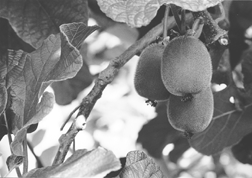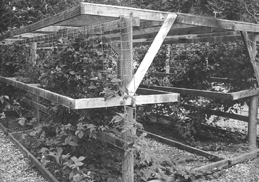

by Terry Kramer
Photos by Brandi Easter

While most of us are making holiday plans in the weeks ahead, Trinidad gardener Pat Wells will be harvesting a heavy crop of kiwis.
Yes, kiwis. The subtropical vine thrives along with currants, blackberries, blueberries, raspberries, strawberries, assorted citrus and fruit trees in Wells' one-plus acre fruit garden.
Surrounded by a six-foot wire fence, fortified with electricity to keep deer and raccoons out, Wells' garden of eatin' occupies only a small portion of a five-acre parcel overlooking the Pacific Ocean. The kiwi vines, clinging to a stout post and wire system, occupy a central spot in the garden.
"Actually it is not unusual that kiwis grow here, even though they are grown commercially in the hot Central Valley. They also grow in New Zealand in places where the climate is similar to here," Wells explained while lifting a heavy cluster of the fuzzy fruit.
According to Wells the fruit should be harvested in December before it ripens. If put in cold storage kiwis will last more than six months. "The problem with leaving kiwi on the vine is if you leave it past December, the vine will take the sugar out of the fruit and put it back into the vine so the fruit then loses its sweetness."
To produce fruit, kiwis need both male and female plants for pollination. A single male pollinates several female plants in Wells' garden. And Wells says kiwis need little maintenance, except for winter pruning after harvest.
They also seem to be unattractive to pests. Kiwi vines have an odd smell which, Wells thinks might help deter pests.
Upon entering the fruit garden, I was impressed by the substantial framework used in the raised beds and the kiwi training supports. Eight-inch diameter, pressure-treated posts support the kiwis. Beds of the kiwis and most of her other fruit-bearing plants are supported by thick, untreated (no creosote) redwood railroad ties. Three- to four-foot wide chip-mulched paths separate all beds, allowing plenty of room to move about with wheelbarrows and tools.
 The 12-by-50 foot double row cage makes harvesting berries easy while protecting the fruit from the birds.
The 12-by-50 foot double row cage makes harvesting berries easy while protecting the fruit from the birds.
A focal point in the fruit garden is the "berry room," a 12-by-50-foot structure of 2-by-4s designed to support blackberries and tayberries (a cross between a blackberry and a raspberry). One can enter the room and pick inside and also migrate down long rows to pick berries on the outside. It is a vertical training system Wells designed.
"I haven't seen it anyplace. When we lived in the Valley we grew our berries on a horizontal type system, and I didn't like that. I just had the idea that if it was vertical you could pick from both sides and it would make it easy to also maintain the vines. This system makes it real easy to train canes for the next season," she said.
While the electric fence keeps the raccoons and deer out, Wells also needs to use netting to keep birds from eating the berries.
"The trick is to net (the berries), and yet make it convenient to get in and pick, which is why we went to this (cage) system. You can easily just throw a net over a plant, but it's a pain in the neck to take the net off to pick," she explained.
Wells also harvests strawberries almost the size of peaches from 3-by-28-foot raised beds. Beds are neatly covered with a white spun material attached to supports of PVC pipe. The beds resemble hospital beds covered with fresh linen.
Wells said the coverings warm the plants for fruiting and also keep the birds out. She has tried several varieties of strawberries over the years and has found that the best are Seascape and Tristar.
Keeping the fruit garden adequately watered poses no problem for Wells because she uses a drip-irrigation system. She doesn't spray plants with chemicals, and she uses manure mulches to supply needed nutrients.
Beyond the berry-growing area is a large orchard of plum, cherry, pear and apple trees. Wells' thriving orchard includes several varieties of fruit trees that -- like her kiwis -- are not supposed to perform well on the coast. She grows Frost peaches, and for the last three summers Wells has harvested large crops. Spraying with lime/sulfur helps deter peach leaf curl, she said.
Wells' Fuji apple trees are another success she is proud of. "Fuji aren't supposed to ripen here, but look at my two fuji trees," she said with a smile. "They have tons of apples."
It takes a lot of time and hard work to maintain this immaculate and expansive fruit garden, but Wells is addicted to it.
"I love to work out here. I don't like doing other things sometimes. It's like intruding in my gardening time. Like if I have to go grocery shopping, or Christmas shopping, to me that is an intrusion into my gardening. I know I've got to get better about that," she laughed. "But I just love gardening, so it's not work to me.
The North Coast Journal Table of Contents